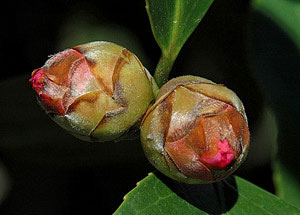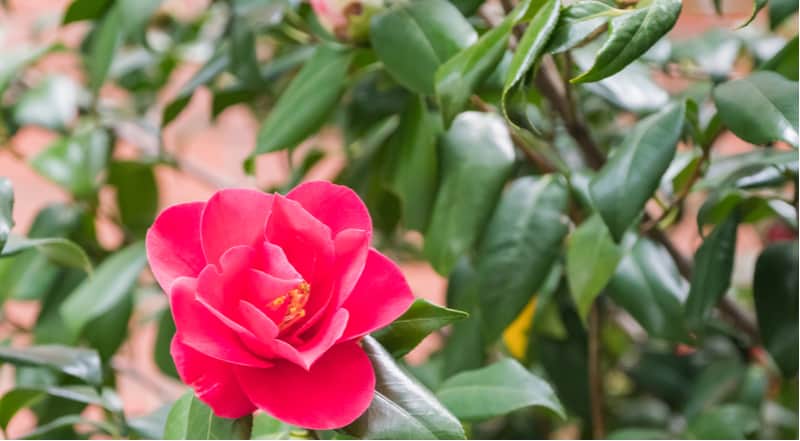
Early spring is when camellias blossom, and the summer months are when the flower buds for the next year begin to form. Although camellias are tough plants, there are a few reasons why they might not be blooming in the spring.
Unfavorable soil conditions, frost damage, improper pruning, excessive fertilizer, excessive shadow, or drought stress are all causes of non-flowering camellias. Frost damage while the camellia’s flower buds are forming is the most frequent cause of lack of flowers.
The reasons why your camellia isn’t flowering can be found in the following paragraphs, along with advice on how to make sure it blooms the following season.
Table of Contents
1. Soil Conditions for Camellia to Flower
For camellias to bloom, the ideal soil conditions are:
- Having a porous structure that allows extra water to drain away, rich loam soil or soil that has been amended with organic matter retains moisture.
- an acidic soil with a pH range of 5.8 to 6.5.
- nutrient-rich soil that receives regular mulching to improve soil structure, contribute nutrients, and preserve water.
The camellia lacks the resources (in terms of soil moisture and nutrients) it needs to flower if the soil is sandy, dry, or deficient in nutrition.
Similarly, low-lying regions or marshy soil caused by heavy clay are not ideal for camellia growth because these conditions favor the growth of fungi that cause illnesses like root rot.
If your camellias are having trouble flowering and they were planted in dry, sandy, or nutrient-poor soil, you should move them or remove them out of the ground and amend the soil with loads of organic matter, such compost, leaf mold, or well-rotted manure.
The ideal soil conditions that the camellia prefers in its natural habitat under tree canopies are replicated by these soil additions.
The camellia can grow better and will experience better growing and flowering conditions if you can alter a larger region around its root ball.
2. Soil pH is Too Alkaline for Flowering
The soil requirements for camellias are similar to those for plants like rhododendrons and azaleas that like acidic soil.
The ideal soil pH range for camellias to flourish and bloom is between 5.5 and 6.5. (7 is pH neutral).
The roots of the camellia cannot reach the nutrients it needs if your soil is too acidic (pH lower than 5.5) or too alkaline (pH higher than 7), which is much more likely. Stressed plants do not flower, and their leaves turn yellow.
If your garden soil is alkaline, it’s possible that a neighbor or local garden enthusiast can tell you; alternatively, you might get a soil testing kit from Amazon to find out.
The ideal way to grow camellias in gardens with alkaline soil is in a pot, container, or raised bed where you can alter the soil’s properties to suit the camellia and encourage flowering.
3. Too Much Fertilizer Causes Fewer Flowers
The nitrogen in fertilizer can encourage plenty of lush green foliage development at the expense of blossoms if it is applied to camellias too frequently or in excess amounts.
Since camellias are not heavy feeders like roses are, they do not need frequent fertilizer to flower in the same way.
The easiest approach to guarantee camellias bloom is to prepare the soil well before planting (by adding tons of compost and organic matter to the soil) and to mulch frequently to feed the soil and supply nutrients.
Even while well-prepared soil gives camellias all the nutrients they need to flower, there are some circumstances in which they can benefit from additional fertilizer:
- To flower, camellias that are grown in pots can use up all the nutrients in the soil and would benefit from fertilizer application.
- Camellias that have been planted in unsuitable conditions, such as sandy, nutrient-poor soils, or those that have not had regular mulching.
Use a particular camellia fertilizer, such as miracle-gro, if your camellia isn’t blossoming and the growth is sparse or spindly and gives the proper combination of nutrients for your camellia with the right amount of concentration to flower.
The level of soil acidity should be maintained so that the roots of the camellia can reach the nutrients necessary for flowering. This can be done by using products designed specifically for camellias.
4. Too Much Shade for Blooming
Camellias that receive too much shade tend to produce more foliage but fewer blooms.
Finding the correct balance for your climate is essential since camellias cannot handle too much sun without suffering from drought or sunburn. However, in cooler regions with more gloomy days and less extreme heat, camellias can survive much more sun exposure.
Consider pruning some branches in the overhanging canopy to mimic the camellia’s optimal natural environment if it is not flowering, or transfer the camellia to a location in the garden that receives morning light and afternoon shade to protect it from the excessive heat.
5. Camellia Flower Buds turned Brown due to Frost damage
As late spring frosts can harm developing blossoms, preventing the camellia from blooming, camellia flowering can vary seasonally.
The ability for camellia to flower is at danger from an early frost in the Fall as the flower buds have not had time to harden off before Winter. Camellias bloom on last years growth and the buds develop in the Summer and flower the following Spring.
When there is a period of reasonably moderate weather followed by an unseasonably cold snap, which frequently leaves the flower buds brown, the phenomena of cold weather harming flower buds and preventing blossoms is very prevalent.
As camellias are more susceptible to frost damage in open and windy locations, planting them in a protected area, such as beneath a tree canopy or by a structure like a shed, fence, or your house, can help reduce the danger.
Since there isn’t much you can do to save frost-damaged flower buds, prevention is always preferable to treatment.
If an unexpected cold snap is predicted, using a cloche or fleece to protect your camellia buds from frost damage overnight can help ensure that they bloom in the spring. Cloches and fleece are available on Amazon and at garden centers.
6. Drought Stress Reduces Flowering
Due of their relatively shallow roots and preference for constantly moist (but not saturated) soil, camellias can suffer in dry, sandy, or fast-draining soil conditions.
The growth of flower buds, from which blooms emerge the following season, can be hampered by drought stress, particularly in the summer, and the length of time this year’s flowers can be displayed can also be constrained.
Therefore, it’s crucial to take care that the soil around the camellia’s roots doesn’t totally dry up.
The following are the best ways to stop drought stress so that camellias can bloom:
- Adding compost, leaf mold, or well-rotted manure to the soil before planting camellias will assist the soil retain moisture.
- Applying a 1-inch layer of mulch all around the camellia can help to retain moisture and keep sunshine away from the soil, which can quickly dry it out.
- To prevent the soil from drying up in the sun during the sweltering afternoons, give camellias some cover (morning sun followed by afternoon shade is excellent).
- Unless they are in their first year of planting, camellias frequently do not need to be watered during most of the year. However, during the warmest and driest weeks of Summer, they do benefit from a generous soak once a week.
Your camellia has enough moisture for good growth, developing flower buds, and blossom longevity with properly prepared soil and occasional watering.
7. Pruning Camellia at the Wrong Time (Removes Flower buds)

After blooming in the spring, camellias develop their flower buds for the following summer’s blooms.
The camellia may not bloom the next year if you prune it in the late summer because you may have removed all the wood and branches that are home to the developing flower buds.
Pruning your camellia (only if necessary) immediately after flowering will prevent you from reducing the growth that produces the flower buds.
The camellia has the rest of the growing season to grow more branches that support developing flower buds if you prune as soon as the flowers fade in the early spring, but if you wait too long, the buds may already be developing and cutting back now would prevent the camellia from blooming the following year.
Key Takeaways:
- Most frequently, frost damage or improper trimming at the wrong time are to blame for camellias’ failure to flower. A late frost may harm budding flower buds, preventing the camellia from blooming.
- Camellia flower buds can be removed during late summer pruning, which will prevent the plant from blooming the following year.
- Fewer flowers may result from sandy, poor soil and drought stress. Rich, constantly moist soil is preferred by camellias in order for them to bloom.
- Given that camellias flower best in dappled sun light, too much shade can diminish flowers. Nitrogen excess might result in abundant leaf growth but few blooms.
FAQ
How many years does it take a camellia to bloom?
Flowers can have a single or double row of petals and can have a diameter of up to 3 inches. A camellia will bloom during a four to six week period. Camellia thrives in the environment where it can be used as a tall foundation planting, a privacy hedge, or an accent plant. It can be cut down to resemble a “little tree.”
How do you get a camellia to flower?
Rich, constantly moist soil is preferred by camellias in order for them to bloom. Given that camellias flower best in dappled sun light, too much shade can diminish flowers. Nitrogen excess might result in abundant leaf growth but few blooms.
Can you force camellias to bloom?
With some magnificent Camellia blossoms from my yard. I just sliced the stem and dipped it into warm water right away. I have blossoms a day later! For an early Spring or Easter bouquet, forced blooms are quite simple to make and look so lovely.
Why are my camellias not flowering?
Unfavorable soil conditions, frost damage, improper pruning, excessive fertilizer, excessive shadow, or drought stress are all causes of non-flowering camellias. Frost damage while the camellia’s flower buds are forming is the most frequent cause of lack of flowers.
What months do camellia flower?
Camellias Bloom When? Over 260 species of the camellia family (Camellia spp.) exist, some of which bloom as early as October. Most flowers should start to bloom in December or January, and you can enjoy their vibrant hues through April.
